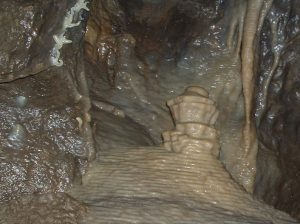Low Douk – 7th May 2014
Low Douk: Richard, Jason
It was my first time to this cave so Richard gave me a full tour. First stop was the ‘second’ entrance (the ‘first’ having collapsed sometime last century). This is a little way to the side of the shakehole and is a snug low crawl after a bold step over a blind pit. Having reached a tiny chamber where it was possible to turn round, he suggested the pitch (“tight”) was a short distance on, and I was happy to take his word for it.
Returning to the surface, we went down the obvious shaft – an easy climb, despite appearances. Then there’s a couple of slithery climbs down boulder chokes, arriving at a traverse line. You don’t really need this (unless you slither out of the boulder choke too fast), but it’s a good landmark.
Traversing horizontally leads to a chamber. Continuing his tour guide role, Richard led up over some boulders to the right and after a little crawling we arrived at the duck which connects to Rift Pot. There was a good air space despite the recent rain, but apparently there was plenty of Low Douk to see yet, so we ‘reluctantly’ gave it a miss.
Returning to the traverse line, Richard invited me to lead into the cave proper. It soon became clear why – attached to the traverse line is a knotted rope which descends into the famous meandering rift. This is impressively high, and very meandering. It’s true that it’s unsuited to the portly caver, but I was able to make reasonable progress without causing Richard too much mirth. A couple of bends did need a determined exhalation to pass, but there was only one place that was definitely a size too small at stream level. Fortunately, it’s not difficult to climb to a higher, slightly wider, level.
Eventually we came to a fine high chamber. A hole in the floor leads to – more meandering rift! This time it’s rather more accommodating and before long we left the stream below and came to a point where the high-level passage parted company from the stream passage, turning off to the left.
Following the stream down an intimidating climb (“not as bad as it looks” – and it wasn’t) leads to the sump chamber, but before we did that, we explored the high-level passage on the left – unknown territory for both of us.
The excitement didn’t last long – the passage turned into a muddy slide into a chamber which went… nowhere. But the cave had a last laugh left for us when we tried to retrace our steps up the muddy slide. It wasn’t very high, but was crucially lacking in hand- or foot-holds. After putting on some fruitless acrobatics for Richard’s amusement, I admitted I needed some help. A combination of walking round the wall with him pushing to stop me sliding down eventually succeeded, and it was Richard’s turn to supply the entertainment. Much to my relief, he didn’t find it any easier than I had, but a small helping tug was effective. All was well, but we agreed it was no place for a solo trip!
The journey back out was uneventful – if fairly strenuous in the narrower meanders – and I was surprised to see we’d only been underground for about 2 hours. An enjoyable trip then, a good work-out with very little crawling and not too far to walk.



